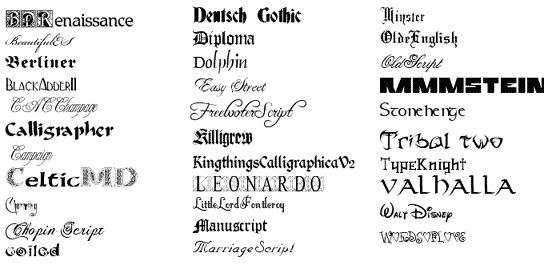To: DiogenesLamp
Fonts were an evolutionary change that was going to happen anyway. You can give Jobs some credit for pushing them early, but in the larger scheme of things, they were coming anyways. Diogenes, you are so dishonest, it is no wonder you need a lamp to find honesty when you make conclusion such as those.
Your statement shows you have no clue what a sea change or how difficult making such a difference it is.

Now, try rotating either of those characters on either the screen or printer to another angle. . . the one on the right is far easier to rotate without distortion than the one on the left.
But more, dropping the idea of the 8X8 character grid made it possible to think outside of the box and edit and use any type of font for any type of typeface, and make them infinitely resizable:

Divorcing the alphabet from the grid did a lot more. . . because you could SPELL check those fonts as well.
This was not trivial, contrary to your dismissive claims and required quite a bit of creativity and the other companies did not figure out how to do it, not because they CHOSE to avoid it, but because they COULD NOT!. So they did not.
When they finally did start doing something like it, they did their text inputting and editing in another program and the spell checking there.
The very definition of a trivial improvement, otherwise known as "cheese". Visually appealing, but functionally of no consequence.
FUNCTIONALLY of NO CONSEQUENCE???? You are daft? Do you realize the fantastic increase in productivity What You See Is What You Get" editing brought to editing newspapers, magazines, printing, layout work, advertising, banner, every kind of print production work in time and re-workng when you no longer had to do trial and error cut and paste on a paste board approach? No functional consequence? Composing to press time was cut to near nothing. You are an idiot if you think it was of no consequence. One major unintended consequence is it ended the exposure of typesetters to LEAD POISONING which had shortened their lives.
Cheese, my rear potootie!
It's a "Logan's Run" Sandman "follower" from 1976. Sort of resembles an Early version of the Iphone, but it was before they had actual screens that worked like that.
It's an early version of an EMPTY BOX with two micro-switches attached to NOTHING. You see that screen at the bottom with the gray rectangles on each corner? Do you know what those rectangles are? MASKING TAPE, holding the window screen inside the EMPTY BOX! The screen is a PHOTO! It's a MOVIE PROP, you dummy. . . it's to a "vision" of an early Iphone (sic) device that inspired Steve Jobs. You have no idea what innovation and invention is all about.
Ivan Sutherland, 1963. Not Steve Jobs.
Sutherland's program used the inputting of complex formulas to draw vector graphics on a cathode ray oscilloscope, not for the display of readable fonts. Another example of your attempting to obfuscate the issues. . . and equate early inventors with later. Non Sequiturs.
My recollection is that an Apple II cost about $1,500 dollars in 1978. A lot of young people couldn't afford them because of the high price. (I was one of them.) Good to know we have Steve Jobs to thank for that bit of A$$holery as well.
Oh, you'd rather he price it like the IBM-PC? OK. The IBM-PC with a single floppy drive and no monitor when it came out was $2499. Happy? The Green Screen monochrome IBM monitor was $499. Even happier?
41 posted on
10/08/2015 5:58:00 PM PDT by
Swordmaker
( This tag line is a Microsoft insult free zone... but if the insults to Mac users continue...)
To: Swordmaker
Your knowledge of computer history is limited to your obsession with all things Apple to the point you sound retarded since you discount the work of others. Anti-aliased fonts were not an Apple invention and had been the work of many other people and companies.
43 posted on
10/08/2015 6:55:25 PM PDT by
CodeToad
(Stupid kills, but not nearly enough!)
To: Swordmaker
Now, try rotating either of those characters on either the screen or printer to another angle. . . the one on the right is far easier to rotate without distortion than the one on the left. Dude, I am quite good at three dimensional vector math, and I have written a lot of code to rotate, shade, texture map, etc, three dimensional objects. I know Jobs didn't come up with any of it, or even the idea of vector based fonts. Why are you trying to give him credit for this?
This was not trivial, contrary to your dismissive claims and required quite a bit of creativity and the other companies did not figure out how to do it, not because they CHOSE to avoid it, but because they COULD NOT!. So they did not.
This is just a rehash of our previous discussion where everything you said Jobs was involved with, I quickly looked up to discover was all done by other people years before he even came on the scene. Jobs simply sat around demanding his software/hardware engineers implement ideas he had already heard of.
Vector graphics were being used all over the place. Remember the game "SpaceWar"?

1977. Vector Graphics.
And what's this?

Spacewar 1962. Vector Graphics.
FUNCTIONALLY of NO CONSEQUENCE???? You are daft? Do you realize the fantastic increase in productivity What You See Is What You Get" editing brought to editing newspapers, magazines, printing, layout work, advertising, banner, every kind of print production work in time and re-workng when you no longer had to do trial and error cut and paste on a paste board approach?
Now I get it. You don't understand how any of this stuff works. To you, it's just "magic." To me, it's just evolutionary advancements of ideas that had already been implemented elsewhere. Printing WUSIWUG is no great difficulty. The essence of every early graphics system is pixel based graphics. Essentially just contiguous locations in memory. If you can draw it, you can print it. Methods of drawing new, neat little things, are just a question of style, not one of brilliant development. (Again, style over substance.)
IBM chose to do Character generator text because it was cheap, saved memory, and allowed them to think they were promoting a "business" computer, rather than a "toy." They deliberately went a different direction.
But now I get it. You don't grasp the nuts and bolts of how this stuff actually works. You don't have the necessary background to recognize it as iterations of the then current art. To you it seems like evidence of Steve Jobs brilliance, to me it just looks like he could browbeat smarter and more knowledgeable people than he was.
It's an early version of an EMPTY BOX with two micro-switches attached to NOTHING.
Yes. Something of about the caliber of a mind as brilliant as Steve Jobs could have come up with. And they thought of it first! :)
The IBM-PC with a single floppy drive and no monitor when it came out was $2499. Happy?
Who would have wanted one of those? They sucked. I wouldn't have been interested in one of those if they had given it to me. Graphics was always my thing, and IBM graphics deliberately sucked in 1980. They didn't come out with anything remotely interesting until around 1990.
No, in 1977+, the best hobbyist computer was the Apple II. Others came out, many of them quite good, but none could match the advantages Apple had from being first and biggest. IBM was crap during this era. It was great for keeping records, or word processing, but I never had any interest in Data Base or that sort of green eyeshade crap.
44 posted on
10/08/2015 6:58:34 PM PDT by
DiogenesLamp
("of parents owing allegiance to no other sovereignty.")
FreeRepublic.com is powered by software copyright 2000-2008 John Robinson



